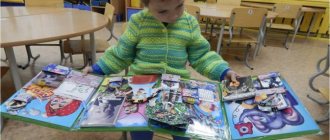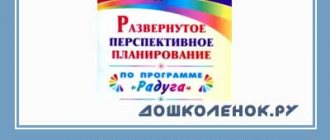Educational areas of the Federal State Educational Standard
Olga Smirnova
Educational areas of the Federal State Educational Standard
1.Physical development:
- development of physical qualities
— correct formation of the musculoskeletal system of the body, development of balance, coordination of movements, gross and fine motor skills
- correct execution of basic movements
– formation of initial ideas about some sports
- mastering outdoor games with rules
— formation of focus and self-regulation in the motor sphere
– mastery of basic norms and rules of a healthy lifestyle
– formation of initial ideas about a healthy lifestyle
- Physical Culture
2. Artistic and aesthetic development:
- development of prerequisites for value-semantic perception and understanding of works of art (verbal, musical, visual , the natural world
- formation of an aesthetic attitude towards the surrounding world
– formation of elementary ideas about types of art
- perception of music, fiction, folklore
- stimulating empathy for characters in works of art
- implementation of independent creative activities of children ( visual , constructive - modeling, musical, etc.)
- introduction to art
— visual arts (drawing, modeling, applique)
- constructive - modeling activity
- musical activity
3.Speech development:
- mastery of speech as a means of communication
— enrichment of the active dictionary
- development of coherent, grammatically correct dialogical and monologue speech
— development of speech creativity
— development of sound and intonation culture of speech, phonemic hearing
— acquaintance with book culture, children’s literature, listening comprehension of texts of various genres of children’s literature
-formation of sound analytical-synthetic activity as a prerequisite for learning to read and write
- speech development
- introduction to fiction
4.Cognitive development:
– development of children’s interests, curiosity and cognitive motivation
— formation of cognitive actions, formation of consciousness
- development of imagination and creative activity
- formation of primary ideas about oneself. Other people, objects of the surrounding world, their properties and relationships (shape, color, size, material, sound, rhythm, tempo, quantity, number, part and whole, space and time, movement and rest, causes and effects, etc.)
- the formation of primary ideas about the small homeland and Fatherland, ideas about the socio-cultural values of our people, about domestic traditions and holidays, about planet Earth as the common home of people, about the features of nature, the diversity of countries and peoples of the world
— development of cognitive and research activities
— familiarization with sociocultural values
– formation of elementary mathematical concepts
- introduction to the natural world
5. Social and communicative development:
— appropriation of norms and values accepted in society, including moral and moral values
- development of communication and interaction of the child with adults and peers
— formation of independence, purposefulness and self-regulation of one’s own actions
— development of social and emotional intelligence, emotional responsiveness, empathy
— formation of readiness for joint activities
— formation of a respectful attitude and a sense of belonging to one’s family and community of children and adults in the organization
— formation of positive attitudes towards various types of work and creativity
— formation of the foundations of safety in everyday life, society, and nature
— socialization, development of communication, moral education
— child in family and community, patriotic education
— self-service, independence, labor education
— formation of security fundamentals
Educational standards and requirements
Preschool education at the present stage is regulated by the Federal State Educational Standard of Preschool Education, approved by Order of the Ministry of Education and Science of the Russian Federation dated October 17, 2013 No. 1155.
On September 1, 2013, the Law “On Education in the Russian Federation” came into force, which establishes preschool education as a separate level of general education, and for the first time in the history of Russian education.
From January 1, 2014, all preschool educational institutions of the Russian Federation switched to the new Federal State Educational Standard for Preschool Education (FSES DO) .
The preschool education standard is a very special document related to supporting the diversity of childhood, and not its unification.
The new standard appears to us as a unique agreement between family and state. The federal state standard for preschool education is a set of state guarantees and requirements for programs, conditions and results of obtaining a free, accessible, high-quality education.
The federal state standard for preschool education is a set of state guarantees and requirements for programs, conditions and results of obtaining a free, accessible, high-quality education.
The Federal State Educational Standard is aimed at achieving the following goals
| Increasing the social status of preschool education |
| Ensuring state guarantees of the level and quality of preschool education based on the unity of mandatory requirements for the conditions for the implementation of educational programs of preschool education, their structure and the results of their development. |
| Preserving the unity of the educational space of the Russian Federation regarding the level of preschool education |
| The state ensures equal opportunities for every child to receive quality preschool education. |
The standard solves the following problems
Preschool childhood is the main and most important stage when the foundations of personal development are laid: physical, intellectual, emotional, communicative. This is the period when a child begins to realize himself and his place in this world, when he learns to communicate and interact with other children and adults.
What is changing in the educational process of preschool educational institutions in connection with the introduction of the Federal State Educational Standard for Preschool Education?
1. The introduction of the Federal State Educational Standard is due to the fact that there is a need to standardize the content of preschool education in order to provide every child with an equal starting opportunity for successful schooling.
But the specificity of preschool age is such that children’s achievements are determined not by the sum of specific knowledge, abilities and skills, but by a set of personal qualities, including those that ensure the child’s psychological readiness for school. Thus, teaching reading and arithmetic is not the goal of preschool education. A preschool institution is designed to help a child painlessly move to a new level of education, develop the child emotionally, communicatively, physically and mentally, and develop abilities and desire to study at school.
The standard includes requirements for results, but this does not mean that kindergarten graduates will have to take exams! There will be no final assessment. With the help of monitoring studies at different stages, the level of development of the child will be recorded so that teachers of preschool institutions and parents understand what needs to be worked on next.
It should be noted that the most significant difference between preschool education and general education is that in kindergarten there is no strict subject matter. Child development occurs through play, not through learning activities. The standard of preschool education differs from the standard of primary education in that preschool education does not have strict requirements for the results of mastering the program.
At the same time, teachers are given a guideline for the ultimate goal of their activities. The Federal State Educational Standard states that one of the mandatory sections of the program of any preschool educational institution is the section “Planned results of children mastering the basic general education program of preschool education.” It describes the integrative qualities that a child can acquire as a result of mastering the program: for example, physically developed, inquisitive, active, emotionally responsive, sociable, etc.
The text of the Federal State Educational Standard does not use the word “occupation,” but this does not mean a transition to the position of “free education” of preschoolers. Adults will not stop working with children in kindergarten. But this form of educational activity as an activity does not correspond to the age characteristics of preschool children. In modern theory and practice, the concept of “activity” is considered as an entertaining activity, without identifying it with occupation as a didactic form of educational activity. The activity should be a specific children's activity that is interesting for children, specially organized by the teacher, implying their activity, business interaction and communication, the accumulation by children of certain information about the world around them, the formation of certain knowledge, skills and abilities.
And what is also very important, the basic preschool education program ensures continuity with the exemplary basic primary education programs, which was not the case before.
2. The Standard’s requirements for the results of mastering the Program are presented in the form of targets for preschool education. These include the following social and psychological characteristics of the child’s personality at the stage of completion of preschool education
Thus, the targets do not represent an assessment of the child’s achievements within a rigid framework: knowledge, abilities and skills, but the social and psychological characteristics of the child’s possible achievements.
It is important that by the end of the preparatory group in kindergarten, the child has formed a strong-willed and motivational readiness to study at school.
3. The new document prioritizes an individual approach to the child through play . The fact that the role of play as a leading activity of a preschooler is increasing and it is given a leading place is positive, since in recent years, due to social changes in society, informatization, as well as the intensive preparation of the child for school, play is unfortunately disappearing from the world of childhood. The child’s social world becomes closed, limited to communication with loved ones or virtual communication. Today, preschool education is designed to bring play back to childhood. That very cognitive, research, creative one, in which the child learns to communicate, interact, with the help of which he learns about the world, the relationships of objects and people in this world. That game in which the child “tryes on” different roles. That game in which his speech, memory, attention, thinking, emotions, imagination develop.
In addition to play, the leading types of children's activities will be: communicative, motor, cognitive-research, productive, etc. It should be noted that each type of children's activity corresponds to certain forms of work with children.
4. The way of organizing children's activities is changing: not the guidance of an adult, but joint (partnership) activities of an adult and a child.
It should be noted that educational activities are carried out throughout the entire time a child is in a preschool institution. This
Educational activities are carried out in various types of activities and cover certain areas of children's development, which are called educational areas . Federal State Educational Standard defines 5 educational areas
1) social and communicative development is aimed at assimilation of norms and values accepted in society, development of communication and interaction of the child with adults and peers, formation of independence
2) cognitive development involves the development of children’s interests, curiosity and cognitive motivation
3) speech development includes mastery of speech as a means of communication and culture, enrichment of the active vocabulary, development of coherent, grammatically correct speech
4) artistic and aesthetic development involves the development of prerequisites for the value-semantic perception and understanding of works of art, the natural world, the formation of an aesthetic attitude towards the surrounding world
5) physical development includes the acquisition of experience in motor activity, the formation of healthy lifestyle values.
Educational areas correspond to the age and individual characteristics of children and are connected with each other. The interconnection of educational areas ensures that the child develops a holistic picture of the world around him.
5. One of the principles of preschool education is the cooperation of the preschool institution with the family , and state standards are the basis for assisting parents (legal representatives) in raising children, protecting and strengthening their physical and mental health, in the development of individual abilities and the necessary correction of their developmental disorders .
In accordance with the Federal State Educational Standard for Preschool Education, a preschool institution is obliged
In this way, the role of parents in the work of the preschool institution increases. Parents must participate in the implementation of the preschool educational institution program, in creating conditions for the full and timely development of the child in preschool age and be active participants in the educational process, and not just outside observers.
Federal documents
| Law “On Education in the Russian Federation” No. 273 FZ dated December 29, 2012 | https://www.edu.ru/abitur/act.30/index.php |
| Sanitary and epidemiological requirements for the design, content and organization of the operating mode of preschool educational institutions | https://www.rg.ru/2013/07/19/sanpin-dok.html |
| “Federal state educational standard for preschool education” Order of the Ministry of Education of the Russian Federation dated October 17, 2013 No. 1155 | https://www.rg.ru/2013/11/25/doshk-standart-dok.html |
| “On approval of the Procedure for organizing and implementing educational activities for basic general education programs - educational programs for preschool education” | https://www.edu.ru/db-mon/mo/Data/d_13/m1014.html |
| “On the procedure for certification of teaching staff of state and municipal educational institutions” Order of the Ministry of Education and Science of the Russian Federation dated March 24. 2010 No. 209 | https://mon.gov.ru/dok/akt/7194/ |
Print Email
Types of children's activities according to the Federal State Educational Standard
Elena Ulevich
Types of children's activities according to the Federal State Educational Standard
Types of children's activities according to the Federal State Educational Standard.
Educator 1 KK Ulevich E.V.
Activity is determined by a specific type of manifestation of a person’s initiative, which involves knowledge, creative understanding of the world around and understanding of oneself in this world.
Regardless of the type of activity , children go through five stages of its development:
1. Independent activity .
2. Difficulty.
3. Joint activities with adults (together, and then side by side)
and with peers.
4. Joint activities with peers .
5. Amateur performance
Each teacher has to set the child up for one or another type of activity several times a day, switching from another activity . At the same time, he uses all the baggage of methodological techniques. It all depends on the appropriateness of using each of them: relevance to the topic, effectiveness in relation to a specific group of children, as well as the content of the material of this technique.
The main task of preschool education is to create favorable conditions for the development of children in accordance with their age and individual characteristics, the development of the abilities and creative potential of each child as a subject of relationships with himself, other children, adults and the world.
5 educational areas of the Federal State are implemented through the organization of various types of children's activities or their integration using a variety of forms and methods of work.
The Federal State Educational Standard identifies 9 types of activities:
1. Play activity is a form of child activity, aimed not at the result, but at the process of action and methods of implementation, and is characterized by the child’s acceptance of a conditional position.
2. Communicative activity is a form of child activity aimed at interacting with another person as a subject, involving coordination and joining efforts with the aim of establishing relationships to achieve a common result.
3. Cognitive and research activity is a form of child activity aimed at learning the properties and connections of objects and phenomena, mastering methods of cognition, contributing to the formation of a holistic picture of the world.
4. Perception of fiction is a form of child activity, which is embodied in internal assistance and empathy for the characters, resulting in the effect of personal presence, personal participation in events.
5. Self-care is a form of child activity that requires effort to satisfy physiological and moral needs and brings a concrete result that can be seen.
6. Construction from various materials is a form of child activity that develops spatial thinking, provides an opportunity for the development of creativity, and enriches speech.
7. Visual activity is a form of child activity that results in the creation of a material or ideal product.
8. Musical activity is a form of child activity that gives him the opportunity to choose the positions that are closest and most successful in realizing the position of listener, performer, and writer.
9. Motor activity is a form of activity of a child that allows him to solve motor problems by implementing a motor function.


